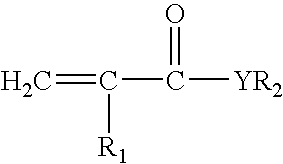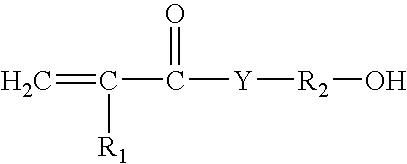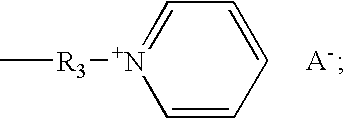Biocidal polyurethane compositions and methods of use
a technology of biocidal polyurethane and composition, applied in the field of biocidal polyurethane composition and composition, can solve the problems of lack of permanence, antimicrobial substance release into the environment with potential adverse effects on desirable flora and fauna, and many of these compounds are toxic to higher forms of life, so as to improve hydrolytic resistance and adhesion, and maintain antimicrobial protection
- Summary
- Abstract
- Description
- Claims
- Application Information
AI Technical Summary
Benefits of technology
Problems solved by technology
Method used
Image
Examples
example 1
Preparation of Quaternary Ammonium Salt of DMAEMA
[0112]A reaction flask was fitted with a condenser, a mechanical stirrer, a thermometer and addition funnel. To the flask 25 parts of DMAEMA (dimethylaminoethyl methacrylate) and 60 parts of acetone was added. To this mixture was added 48.7 parts of 1-bromohexadecane from the dropping funnel in 30 minutes. The mixture was stirred at 35° C. for 16 hours. Then the reaction mixture was allowed to cool to room temperature and a white solid precipitated out of the solution. The precipitated solid was filtered and washed with cold ethylacetate. The solid was dried in the vacuum oven at 30° C. for 4 hours. A 1H NMR spectrum of the compound revealed the formulation of the desired compound DMAEMA-C16 monomer.
Preparation of Polyurethane Having an Antimicrobial Quaternary Ammonium Salt:
[0113]A dispersion was prepared in three sequential steps: 1) an isocyanate terminated prepolymer was prepared at 80° C., in a resin reactor, equipped with a refl...
example 2
Comparative Example
[0117]A prepolymer was prepared without DMAEMA-C16, with the similar technique as in example 1, with 12.19 g TEGO-HSI 2311, 16.23 g DESMODUR W, 10 g g N-methylpyrrolidone, 0.01 g of T-12, 7.87 g TERATHANE-2000, 0.5 g PRIPOL-2033, 16.22 g PRIPLAST 3192, 3.0 g of N-methyl diethanol amine and 0.5 g of hydroxy ethyl acrylate.
[0118]The resulting prepolymer was dispersed in 90 g of water containing 1.2 g of acetic acid. Then 2.9 g of adipic acid dihydrazide dissolved in 40 g hot water was added and mixed for 8 hours at 40° C. A milky white dispersion was obtained.
example 3
[0119]This example illustrates polyurethane prepared from alkylamidoalkyldimethylamines and halo alkanolamine
[0120]The hydroxy quat of alkylamidopropyldimethylamine was prepared by adding 37.34 g of stearamidopropyl dimethylamine (INCROMINE SB) which was washed with warm water, acetone and then dried in vacuum) in 40 g toluene and heated at 105° C. in flask equipped with mechanical stirrer, reflux condenser and a dropping funnel. To this 12.66 g of 2-Bromoethanol was added drop-wise and reacted for at least 2 hours. After cooling, the salt was filtered through a Buchner funnel and washed with toluene. The salt was then dried at 35° C. for 16 hours. A prepolymer was prepared by reacting 1.2 g 1,6 hexane idol, 36 g PRIPLAST 3196, 20 g STEPANOL PH-56, 36 g DESMODUR-W, 10 g N-methyl pyrrolidone, 2 drops T-12 at 80° C. for 3 hrs 30 min in a reaction flask equipped with mechanical stirrer, thermometer, and a reflux condenser. Then 4.5 g of N-methyldiethanol amine was added and reacted fur...
PUM
| Property | Measurement | Unit |
|---|---|---|
| Volume | aaaaa | aaaaa |
| Fraction | aaaaa | aaaaa |
| Time | aaaaa | aaaaa |
Abstract
Description
Claims
Application Information
 Login to View More
Login to View More - R&D
- Intellectual Property
- Life Sciences
- Materials
- Tech Scout
- Unparalleled Data Quality
- Higher Quality Content
- 60% Fewer Hallucinations
Browse by: Latest US Patents, China's latest patents, Technical Efficacy Thesaurus, Application Domain, Technology Topic, Popular Technical Reports.
© 2025 PatSnap. All rights reserved.Legal|Privacy policy|Modern Slavery Act Transparency Statement|Sitemap|About US| Contact US: help@patsnap.com



